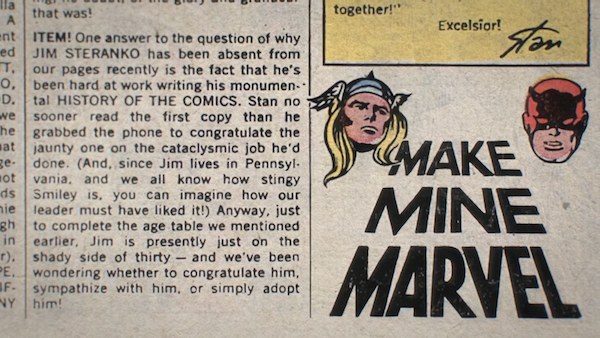Movie review by Greg Carlson
An online search for articles about David Gelb’s documentary “Stan Lee” returns a lengthy list of headlines summarizing what has been, for many years, the story about the story. Even many non-fans know that the recognizable face of Marvel Comics was an opportunist and self-promoter, often reluctant to share the proper amount of creative credit with giants like Jack Kirby and Steve Ditko. But Lee’s influence on the industry he helped build is as undeniable as his affinity for purple prose. Decades of mythmaking and the careful retelling of core talking points have polished Lee’s biography to shine as brightly as the inevitable outcome of any Horatio Alger plot.
So if you are looking for a critical examination of Lee’s life and work, or a thoughtful consideration of his failures and shortcomings, Gelb’s movie is not for you. That said, the filmmaker – whose “Jiro Dreams of Sushi” remains a delight – deserves some credit for at least acknowledging the partnerships that yielded colorful 20th century icons like Spider-Man, the Fantastic Four, the X-Men, and the Hulk. Similar to the approach used by Davis Guggenheim in the much sharper and more affecting Michael J. Fox documentary “Still,” Gelb builds the on-camera and off-camera narration almost entirely from a single voice. In this case, the voice belongs to Stan Lee.
Unsurprisingly, Kirby family members issued a statement calling out the film for the continuing erasure of Jack Kirby’s true contributions from the historical Marvel record. Neal Kirby writes, “Stan Lee had the fortunate circumstance to have access to the corporate megaphone and media, and he used these to create his own mythos as to the creation of the Marvel character pantheon.” Kirby also noted that a long life also advantaged Lee. In the movie, Gelb excerpts – without comment – part of the infamous WBAI “Earthwatch” radio show interaction between Lee and Kirby that happened on the occasion of Kirby’s 70th birthday in 1987.
Completists know that “With Great Power: The Stan Lee Story” (2010) is another valentine – one that does go heavy on the gushing celebrity admirer soundbites. In the new film, Gelb’s access to the massive trove of historical photos (which show without fail the wild evolution of Lee’s wigs, toupees, and hair plugs), television appearances, and of course, the pages of comic books and related artwork, provides a handsome look, although the decision to use so many inserts of model train-like scale dioramas of banal office scenes is less clear. Sections detailing Lee’s longtime partnership with wife Joan and the arrival of Flo Steinberg to the Marvel team temporarily break up the boys club.
Author Abraham Josephine Riesman, who wrote the Eisner- and Hugo-nominated “True Believer: The Rise and Fall of Stan Lee,” is one of many to criticize Gelb’s movie as a corporate hagiography. In a piece for “Vulture,” Riesman takes issue with, among other things, the way in which Disney and Gelb let Lee’s elder “abusers off the hook by deleting them and their actions from Stan’s life.” Riesman understands that Lee was both “a towering American original” and “a trademarked brand.” Gelb’s movie could have used a lot more reflection to account for the complex terrain between those poles.
